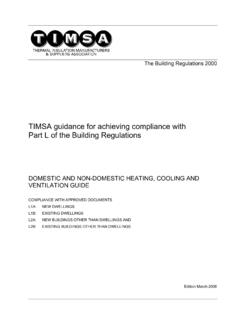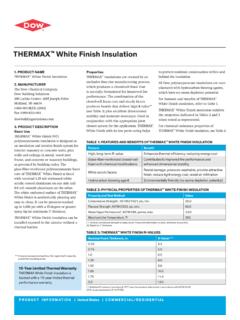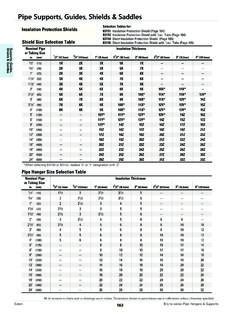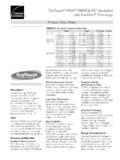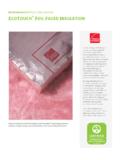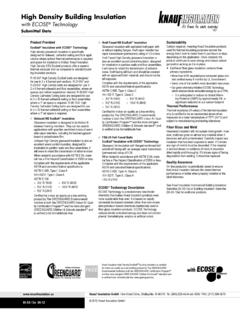Transcription of THERMAL INSULATION OF H & V DUCTWORK - TIMSA
1 Association House, 99 West Street, Farnham, Surrey GU9 7EN tel: 01252 739 154 fax: 01252 739140 THERMAL INSULATION OF H & V DUCTWORK TIMSA s recommendations for installing THERMAL INSULATION to the outer surface of H&V DUCTWORK . It is not applicable to the installation of sound absorbent linings of for the installation of fire protection INSULATION . TGN 3 TGN3 2 GENERAL INSULATION PRINCIPLES THERMAL INSULATION should be applied to all H&V DUCTWORK unless specified otherwise by the purchaser. DUCTWORK conveying warm air should be insulated to conserve energy.
2 DUCTWORK conveying chilled air or cold supply air should be insulated to conserve energy and control condensation at the external surface. Boiler exhaust DUCTWORK should be insulated to reduce the external surface temperature to a safe level and prevent condensation of exhaust gases inside the DUCTWORK . Recommendations for the specification and installation of THERMAL INSULATION and finishes are given in BS 5422: 1990 and BS 5970: 1992. THERMAL INSULATION materials used should be manufactured and tested under an approved ISO-9002 Quality management System and comply with the relevant British Standard specification if available. (See TIMSA 's INSULATION Industry Handbook.)
3 They should be suitable for continuous use without degradation throughout the range of operating temperatures and should provide proof against rotting, mould, fungal growth and attack by vermin. Products containing CFCs in their manufacture should not be used. The required fire behaviour properties of insulating materials and finishes will depend on the location where they are to be installed and should conform to the relevant section of BS 5422: 1990, the Building Regulations Approved Document B or other requirements if specified by the purchaser. On chilled air and cold air supply ducting a fully sealed vapour barrier should be applied to the external warm face of the INSULATION to prevent ingress of moisture vapour.
4 The permeance of the vapour barrier should not exceed ( ) when tested by the approved method in either BS 3177 or BS 4370. The vapour barrier should not reduce the fire rating of the complete INSULATION assembly as above. (See BS 5422: 1990 Section ) For systems operating between -10 C to 0 C, a permeance rating not exceeding ) should be used. INSULATION should be selected and installed in accordance with the recommendations given in BS 5970: 1992 and at thickness complying with BS 5422: 1990. DUCTWORK should be tested for air leakage as specified prior to the application of THERMAL INSULATION . THERMAL INSULATION PRODUCTS A wide range of types of THERMAL INSULATION products is available for use on rectangular, circular or flat-oval ducting.
5 These comprise rigid preformed slabs or boards and flexible rolls, blankets, mats and mattresses. Most are available with a factory applied finish of reinforced aluminium foil or are suitable for the application of site applied finishes. Initially, the suitability of a product will be decided by certain key properties such as THERMAL performance, operating temperature, fire safety and economic considerations. However, the final choice of product may involve the consideration of numerous other properties which are pertinent to that particular project. Examples are mechanical strength, durability, compatibility, resistance to chemicals, oil and moisture.
6 Manufacturers will readily supply all this information but the table below lists the key properties for several types of THERMAL INSULATION products which are used on H&V DUCTWORK . TGN3 3 Table of key properties Density THERMAL conductivity Operating temperature ( kg/m3) ( W/mK @ 10 C) ( C) Glass mineral wool 10 - 80 @ 48kg Cryo to 230 Rock mineral wool 45 - 80 @ 45kg Up to 800 Expanded polystyrene 15 - 30 @ 20kg -100 to 80 Calcium silicate 240 Ambient to 1000 Cellular Glass 120 and 136 @ 120kg -260 to 430 Polyurethane foam 35, 40, 50 @ 40kg -180 to 110 Polyisocyanurate foam 32, 40, 50 @ 40kg -180 to 140 Phenolic foam 35 - 60 @ 40kg -180 to 120 Polyethylene 30 -50 to 105 Nitrile rubber 60 and 90 @ 60kg -40 to 105 Note : THERMAL conductivity measured to BS 874 for mineral wools, BS 5608 for polyurethane and polyisocyanurate.
7 METHODS OF APPLICATION Fixing methods should minimise the occurrence of direct metal paths where THERMAL bridging may cause localised high temperatures at the aluminium foil surface. The full insulating effect should be maintained at connections and access openings and panels including the edges of such openings. The INSULATION should cover all forms of flanged joints, fastenrs or stiffeners either by means of purpose-made covers or by increasing the general thickness of INSULATION to give appropriate cover. Where multiple-layer INSULATION is applied, the joints in each layer should be staggered. The INSULATION outer covering and, where applicable, the vapour seal, should be continuous and should not be pierced or fouled by any of the supports.
8 INSULATION at supports should be with a product of suitable compressive strength to carry the loads transmitted to the supports. Such load-bearing INSULATION should be extended by a minimum of 50mm each side of such locations in order to facilitate sealing the vapour barrier. Where slab INSULATION products are used on rectangular DUCTWORK , they should be applied so that product on the horizontal face overlaps that on the vertical face to maintain thickness at corners. They should be installed securely with adhesive which may be supplemented by INSULATION hangers and washers or bands of reinforced adhesive foil tape when recommended by the INSULATION manufacturer.
9 Such fasteners may be rustproof metal studs, split prongs, plastic studs or other approved devices fixed to the duct surface and should be suitable for the thickness and weight of INSULATION and its finishings to be applied. Fastenings should be spaced at approximately 300mm centres and should finish flush with or below the surface of the INSULATION . Adhesives should be compatible with the DUCTWORK , INSULATION and vapour seal. All joints and fixings should be sealed with tape of the same material as the INSULATION facing. When flexible roll or compression resistant mineral wool products are used, the INSULATION can be secured to the DUCTWORK with 150mm wide bands of suitable adhesive tape first applied to the DUCTWORK surface at 300mm centres.
10 Circumferential and longitudinal joints should be sealed with tape of the same material as the INSULATION facing. If no protective finish or cladding system is to be installed, the external surface of the INSULATION should be wrapped with galvanised wire netting of 25mm mesh and 1mm thickness, complying with BS 1485 and the netting joints should be secured with a lacing of 1mm galvanised wire. Care should be taken to ensure that the insulating material is not compressed during application. TGN3 4 TYPES OF INSULATION FINISHES INSULATION finishes are applied over the INSULATION itself to provide, depending upon type used, a vapour barrier, weather protection, chemical resistance, protection from mechanical damage or improved aesthetics.

